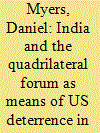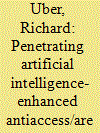| Srl | Item |
| 1 |
ID:
176614


|
|
|
|
|
| Summary/Abstract |
In the Indo-Pacific, China is waging a well-orchestrated campaign to displace
US hegemony and secure a favorable balance of power. Driven by ardent nationalistic goals, the Chinese Communist Party is silencing political outliers and challenging the boundaries of international sovereignty. The first half of this article
outlines Chinese political ambitions and domestic civil rights violations levied in
pursuit of the government’s agenda. It then addresses how Chinese territorialism
in the South China Sea has undermined the utility of bilateral US strategic partnerships. The second half of the article describes the threat China poses to India’s
national security and why the Indian Air Force is particularly unprepared to meet
this challenge. The article concludes by suggesting a quadrilateral treaty alliance
between the United States, India, Japan, and Australia is needed to prevent further Chinese adventurism and preserve regional stability
|
|
|
|
|
|
|
|
|
|
|
|
|
|
|
|
| 2 |
ID:
176616


|
|
|
|
|
| Summary/Abstract |
Indonesia is the world’s fourth most populous nation (273 million people) and
abuts the globe’s busiest trade route (the Straits of Malacca); as such, Indonesia is on track to become the world’s fourth-largest economy by 2050.1
Indonesia will be a major venue for US–China geo-economic competition in the
Indo-Pacific. It was no accident that Pres. Xi Jinping chose Jakarta to unveil
China’s proposal for a Maritime Silk Road in October 2013, a plan that evolved
into China’s global Belt and Road Initiative (BRI). Pres. Joko “Jokowi” Widodo
embraced the BRI to help solve Indonesia’s infrastructure needs, signing deals
worth billions of dollars in Chinese investment. At the same time, Jokowi established Indonesia as a model for how a developing nation can protect itself from
undue Chinese influence by setting key conditions on BRI projects and pursuing
alternate foreign investment partners. Despite providing development finance to
Indonesia for decades, Washington was slow to incorporate its efforts into the US
regional vision of a “free and open Indo-Pacific” (FOIP). The delay gave Beijing
an opening to present itself as the partner of choice for infrastructure development and allowed the BRI to dominate public discourse.
|
|
|
|
|
|
|
|
|
|
|
|
|
|
|
|
| 3 |
ID:
176615


|
|
|
|
|
| Summary/Abstract |
To ensure a free and open Indo-Pacific, the United States Air Force (USAF) must
maintain its ability to freely operate in international airspace and project force
forward to deter aggression. Future improvements to antiaccess/area-denial (A2/
AD) systems will certainly include artificial intelligence (AI). AI is a strategic
priority of our adversaries, as it can provide significant benefits for national defense. The USAF must be prepared to tackle these technical challenges to uphold
our regional commitments and protect international interests in the IndoPacific. Three specific applications relevant to A2/AD are (1) target recognition
from multiple fused data sources, (2) improved war gaming with agent-based
models, and (3) blockchain-enabled autonomous systems. This article will introduce how these technologies might be integrated into future A2/AD systems and
recommend some strategies for addressing and overcoming these challenges.
|
|
|
|
|
|
|
|
|
|
|
|
|
|
|
|
| 4 |
ID:
176613


|
|
|
|
|
| Summary/Abstract |
The prospect of increasingly autonomous systems has seized the military imagination and rapidly generated an international debate surrounding the merits of a
potential preemptive ban under international law. What has been missing to this
point has been an in-depth consideration of how artificial intelligence, autonomous systems, and unmanned platforms would be perceived by the junior officers
who will play a core role in their integration into future militaries. Drawing on a
broad survey of officer cadets and midshipmen at the Australian Defence Force
Academy conducted in 2019, this article provides an analysis of how perceived
risks and benefits of autonomous weapon systems are influencing the willingness
of these future defense leaders to deploy alongside them.
|
|
|
|
|
|
|
|
|
|
|
|
|
|
|
|
| 5 |
ID:
176617


|
|
|
|
|
| Summary/Abstract |
On the night of 15 June 2020, Sino-Indian tensions flared into fighting
along the disputed border in the region known as the Galwan Valley. The
fighting led to the first casualties along the border in 45 years. However,
no one on either side fired a single shot.1
Instead, soldiers threw rocks and used
wooden clubs wrapped in barbed wire to attack one another. Two of the most
powerful armies in the world, both of which possess nuclear weapons, clashed
with one another using sticks and stones
|
|
|
|
|
|
|
|
|
|
|
|
|
|
|
|
| 6 |
ID:
176612


|
|
|
|
|
| Summary/Abstract |
Since the publication of the Trump administration’s first National Security
Strategy (NSS) on 18 December 2017, there has been much discussion about
the extent to which a state of strategic competition exists between the
United States and the People’s Republic of China (PRC). As many commentators
note, neither the existence of competition nor the ideas in the NSS are particularly
new.
However, a difference in tone, attributed at least in part to the unabashed
use of “America First” to describe the strategy, has led many to view it as more
competitive than past strategies.
|
|
|
|
|
|
|
|
|
|
|
|
|
|
|
|
| 7 |
ID:
176618


|
|
|
|
|
| Summary/Abstract |
The fictional account above illustrates where the Department of the Air
Force (DAF) could find itself in this new decade. It is possible that the
DAF will develop the technical ability to exploit enemy systems but not
possess the language expertise to make use of the information. More than a theoretical possibility, the People’s Liberation Army (PLA) started developing a
Chinese-based operating system in 2019.1
The PLA’s knowledge of US systems,
language, and culture gives it asymmetric leverage against the United States. The
USAF has responded to the situation by establishing the 16th Air Force to lead
operations in the information environment. In the future, the DAF must also
increase its linguistic and cultural competency to ensure the service is eliminating
vulnerabilities.
|
|
|
|
|
|
|
|
|
|
|
|
|
|
|
|